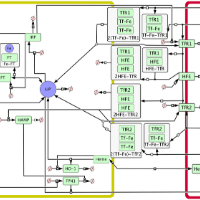 As part of the CRBM’s annotation and simulation service, we have selected the following models which abide by the agreed standards and annotation practices as defined in Annotation Protocol. These models cover a wide range of domains and include semantic annotations of physical processes (including chemical reactions, molar flow rates, rates of changes of concentration, current flow, etc), physical forces (forces, pressures, electrical potential) and user-defined processes. Researchers and curators should use these models as a guideline when annotating models together with the aforementioned annotation protocol.
As part of the CRBM’s annotation and simulation service, we have selected the following models which abide by the agreed standards and annotation practices as defined in Annotation Protocol. These models cover a wide range of domains and include semantic annotations of physical processes (including chemical reactions, molar flow rates, rates of changes of concentration, current flow, etc), physical forces (forces, pressures, electrical potential) and user-defined processes. Researchers and curators should use these models as a guideline when annotating models together with the aforementioned annotation protocol.
- Paper/Model Information
- Example 1
- Chickarmane et al 2006
- Protein Signalling: Transcriptional Dynamics of the Embryonic Stem Cell Switch, Chickarmane et al 2006
- Link to COMBINE archive: https://doi.org/10.17608/k6.auckland.8251520
- Examples of what was annotated:
- Chemical concentrations of transcription factors OCT4, SOX2 and NANOG.
- Chemical molar flow rate of transcription factors within the compartment of the Embryonic Stem Cell
- Model encoding format: SBML L3V1.
- Example 1
-
- Example 2
- Smith et al 2004
- Cardiovascular: Minimal haemodynamic system model including ventricular interaction and valve dynamics, Smith et al 2004
- Link to COMBINE archive: https://doi.org/10.17608/k6.auckland.8251505
- Examples of what was annotated:
- Change in blood volume through the right and left ventricles
- Change in blood volume through pulmonary arterial tree
- Change in blood volume through pulmonary venous tree organ
- Change in blood volume through the vena cava
- Change in blood flow rate through the aortic valve
- Model encoding format: CellML 1.0
- Example 2
-
- Example 3
- Aslanidi et al, 2009
- Electrophysiology: Mechanisms of Transition from Normal to Reentrant Electrical Activity in a Model of Rabbit Atrial Tissue: Interaction of Tissue Heterogeneity and Anisotropy, Aslanidi et al, 2009.
- Link to COMBINE archive: https://doi.org/10.17608/k6.auckland.8251499
- Examples of what was annotated.
- Change in chemical concentration of intracellular calcium in the sarcoplasmic reticulum of a cardiac muscle
- Change in chemical concentration of potassium in the junctional sarcoplasmic reticulum of a cardiac muscle
- Change in concentration of Calcium in the cytosol of cardiac myocyte
- Change in intracellular Sodium in the cytosol of a cardiac myocyte
- Sarcoplasmic reticulum release compartment calcium current.
- Model Encoding format: CellML 1.1
- Example 3
-
- Example 4
- Gérard and Goldbeter, 2009
- Circadian Rhythms: Temporal self-organization of the cyclin/Cdk network driving the mammalian cell cycle, Gérard and Goldbeter, 2009
- Link to COMBINE archive: https://doi.org/10.17608/k6.auckland.8251529
- Examples of what was annotated
- Change in chemical concentration of transcription factor AP-1 in a mammalian cell
- Change in chemical concentration of Serine/threonine-protein kinase ATR
- Change in chemical concentration of cyclin A, cyclin B and cyclin D, in both active and inactive states
- Model Encoding format: CellML 1.1
- Example 4
-
- Example 5
- Mitchell and Mendes, 2013
- Metabolism: A Computational Model of Liver Iron Metabolism, Mitchell and Mendes, 2013.
- Link to COMBINE archive: https://doi.org/10.17608/k6.auckland.8251574
- Examples of what was annotated
- Change in chemical concentration of TfR2 gene
- Chemical molar flow rate of ferroheme
- Chemical molar flow rate of Transferrin within the liver cell
- Model Encoding format: SBML L2V4
- Example 5

